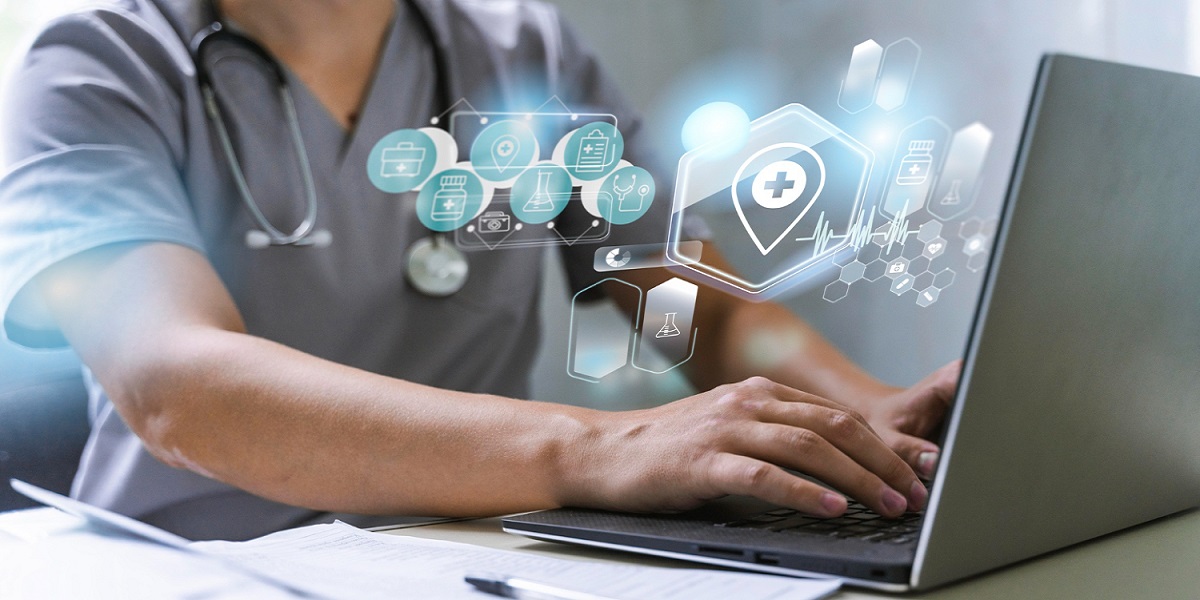Custom mHealth App Development: A Guide for Beginners

The development of custom mHealth apps is gaining traction as individuals seek ways to manage their health through smartphones. These applications assist users in tracking fitness activities, monitoring medical conditions, and connecting with healthcare professionals. This guide aims to help beginners grasp the process of creating a custom mHealth app from the ground up, outlining the steps and valuable tips to embark on this journey.
Whether you're a developer or simply interested, this article offers helpful insights.
Understanding mHealth and Its Importance
mHealth enables integration of mobile applications, health monitoring, and wearable devices to connect healthcare providers and patients. It simplifies health data collection, including medical history and health parameters, making it easier for patients to track their health. These apps enhance patient engagement by allowing users to schedule appointments, receive automated reminders, and access their health records anytime.
They empower patients by providing easy communication with healthcare providers, leading to informed decision-making about their care. For many populations, especially those with chronic conditions, mHealth offers remote patient monitoring, facilitating access to necessary healthcare without visiting a facility. This improves the treatment process and patient experience while ensuring adherence to industry regulations. By incorporating features like video streaming and seamless data exchange, mHealth apps streamline workflows in healthcare facilities.
Key Features of mHealth Applications
Health Monitoring Solutions
When selecting effective health monitoring solutions for patients, developers should focus on user expectations, including ease of use and the ability to track health parameters relevant to their needs. Mobile health apps can enhance patient engagement by enabling features like automated reminders, appointment scheduling, and activity tracking, leading to better management of chronic conditions.
These apps also allow healthcare providers to access patient data, improving the treatment process through streamlined communication and seamless data exchange. Ensuring data security is important; app developers must follow industry regulations to protect sensitive health information, such as medical history and health records. This promotes trust and readiness among patients using healthcare apps for remote patient monitoring and care.
Healthcare facilities benefit from mobile applications and wearable devices that improve workflow and efficiency, ultimately enhancing the overall patient experience while providing ongoing maintenance support. By integrating video streaming and comprehensive health information exchange, health monitoring solutions contribute to informed decision-making in medical care.
Telehealth App Functionality
A telehealth app should feature video streaming for consultations, appointment scheduling, and communication tools to facilitate interactions between patients and providers. It enables patients to book appointments and receive automated reminders, enhancing their experience and efficiency in managing healthcare facilities.
The app must securely store health data, including electronic health records and medical history, ensuring sensitive information is shared safely while adhering to industry regulations. By incorporating health monitoring apps and wearable devices, providers can track health parameters in real-time.
This approach assists in managing chronic conditions through remote patient monitoring, allowing personalized treatment processes without the need for an office visit. Integrating user profiles supports seamless data exchange, providing a complete view of a patient's health information.
Such solutions back services like urgent care and mental health, ensuring a rounded approach to remote care. App developers should focus on quality control and ongoing maintenance to meet user expectations and enhance the app's overall functionality in the healthcare sector.
AI-Powered Solutions in mHealth
AI-powered solutions are transforming patient interactions with healthcare. Through mHealth apps, patients receive automated reminders for medication and appointments, aiding adherence to treatment plans. These applications improve patient experience by facilitating health monitoring and offering features such as activity tracking and appointment scheduling.
AI algorithms enhance the accuracy of health monitoring by analyzing patient data, assisting healthcare professionals in making informed treatment decisions. This technology enables remote patient monitoring, allowing healthcare facilities to observe health parameters in real-time. Nevertheless, app developers encounter challenges like ensuring compliance with regulations and meeting user expectations for smooth data exchange. Continuous focus on quality control and ongoing maintenance is necessary to align the apps with users’ needs.
With the addition of video streaming and health information exchange, mHealth solutions foster efficient workflows, empowering healthcare providers to offer improved care, particularly for those with chronic conditions. Balancing user profiles and medical history is significant for promoting better communication between patients and their healthcare providers.
Steps in Custom mHealth App Development
Identifying Target Audience
When identifying the target audience for mHealth apps, demographic characteristics such as age, gender, and health conditions should be considered. Different age groups may prefer various features, with younger users likely enjoying video streaming for remote care, while older users might prioritize health monitoring and appointment scheduling.
Understanding specific health needs and behaviors, such as the management of chronic conditions or the use of wearable devices, assists in tailoring app development to meet patient expectations. Gathering insights can involve surveys and focus groups, allowing app developers to hear directly from patients about their experiences and preferences. Engaging healthcare providers during development can enhance communication and workflow, ensuring that health data and medical history integration complies with industry regulations.
User profiles can be created to align features like automated reminders and activity tracking with individual treatment processes, while quality control measures guarantee that ongoing maintenance meets user needs. After launch, facilitating seamless data exchange and sharing electronic health records can significantly improve patient care and the overall experience within healthcare facilities.
Defining Core Features
When outlining the main features of mHealth apps, significant functionalities include health monitoring, appointment scheduling, and smooth data exchange. Users, including patients and healthcare providers, expect features that allow easy access to health records, automated reminders for medications, and remote patient monitoring to manage chronic conditions.
To align with user preferences, app developers should conduct surveys and focus groups, gathering insights on patient experiences and desires regarding features like user profiles and communication tools. The effectiveness of these features can be assessed through criteria like efficiency in patient care, the accuracy of health data tracking, and the user-friendliness for healthcare facilities. High-quality health information exchange and integration with wearable devices can enhance treatment processes and improve health management.
Continuous quality control and ongoing maintenance are also necessary to refine features based on user feedback and evolving industry regulations.
Additionally, functions like video streaming for remote consultations can enhance the patient experience and support healthcare providers in their workflows.
Choosing the Right Technology Stack
When choosing a technology stack for mHealth app development, it is important to consider factors such as user profiles, health data, and the complexity of health monitoring features. The specific needs of patients and healthcare providers shape the decision.
For example, an app that enables video streaming for remote care will necessitate different tools compared to one that focuses only on activity tracking. Scalability is important for accommodating user growth, including features like appointment booking and real-time health monitoring without sacrificing performance. Maintainability impacts ongoing upkeep; a well-structured app allows for easier updates and quality control, crucial for managing patient data and health records. The choice of technology can also affect communication among healthcare facilities and the efficiency of hospital-related tasks.
A robust stack enables smooth data exchange for electronic health records, making health information accessible for patient care and chronic condition management. Thus, grasping user expectations and workflow is important for developing effective mHealth solutions.
Essential Certifications in mHealth App Development
Developers in mHealth app development should consider certifications like HIPAA and HITECH to ensure that patient data is secure and that apps adhere to privacy laws. These certifications help healthcare providers trust that mHealth apps protect health records and support effective communication with remote care and health monitoring.
Additionally, certifications enhance the patient experience by ensuring that health monitoring apps meet industry standards for quality control, which includes features such as automated reminders, appointment booking, and seamless data exchange. This builds credibility and makes it easier for app developers to market their products effectively. Moreover, complying with industry regulations enables better integration of wearable devices and health information exchange, contributing to treatment processes and chronic condition management.
When healthcare facilities use certified mobile applications, they can improve workflow and meet user expectations, resulting in a positive impact on patient care and satisfaction, ultimately driving the success of mHealth solutions.
Designing User-Friendly Interfaces for Wellness Apps
Importance of UX/UI Design
Effective UX/UI design enhances user enjoyment of mHealth apps. A clear design allows patients to easily access health monitoring tools, such as activity tracking and appointment booking, making it simpler for them to interpret their health data and medical history. When an app is difficult to navigate, patients may discontinue using it, negatively impacting their treatment.
Effective design also contributes to better communication between healthcare providers and patients, and enables smoother workflows and efficient data sharing. For instance, automated reminders for medication or appointments can boost patient engagement. A well-crafted app assists in remote patient monitoring and allows users to track health indicators while adhering to industry regulations. By aligning with user expectations and improving patient experience, mHealth solutions with effective UX/UI design can enhance patient retention and compliance with health management programs.
Ongoing quality control and maintenance in app development further ensure that these mobile applications serve users well and enhance patient care in healthcare settings.
Creating Engaging User Experiences
To boost user engagement in mHealth applications, strategies such as integrating feedback systems and personalization are effective. App developers can regularly gather user opinions through surveys or in-app prompts. This approach helps identify areas for improvement, such as simplifying appointment booking or enhancing health monitoring features. Personalization can greatly improve patient experiences by allowing users to create profiles that track their medical history and health parameters.
Features like automated reminders for medication or appointments and sharing health data with healthcare providers empower patients to take charge of their care.
Additionally, smooth data exchange between wearable devices and mobile applications enables real-time health monitoring and communication, enhancing the efficiency of health management. These enhancements aim to meet user expectations while complying with industry regulations. By focusing on ongoing maintenance and quality assurance, mHealth apps can adapt to evolving user needs. Features like video streaming for remote patient monitoring also provide valuable support, ensuring patients receive comprehensive care throughout their treatment journeys.
Implementing Remote Patient Monitoring Features
When adding remote patient monitoring features in mhealth apps, engaging users and collecting health data effectively is vital. App developers should ensure seamless data exchange by integrating wearable devices that track health parameters like heart rate and activity levels. These features enhance patient outcomes by allowing healthcare providers to access real-time patient data, supporting timely medical care and personalized treatment plans.
Easy communication between patients and healthcare providers is another significant factor, as it improves the patient experience and addresses questions about medical history or treatment processes. Challenges may arise, such as adhering to industry regulations and maintaining quality control. To address these issues, ongoing maintenance and automated reminders can streamline workflows and prompt patients about health monitoring tasks.
Additionally, features like appointment scheduling and user profiles can help keep track of hospital-related tasks and health information. By concentrating on these areas, healthcare facilities can improve efficiency and provide better care for patients with chronic conditions.
Integrating Telemedicine Platform Systems
When integrating telemedicine platform systems, developers focus on seamless data exchange to enhance patient care and health monitoring. This includes establishing strong connections between mhealth apps, healthcare providers, and wearable devices. It is important to select the right technology, as it impacts the performance of mobile applications and the efficiency of communication and workflow within healthcare facilities.
App developers are encouraged to use reliable programming languages and tools that support health information exchange and provide robust automated reminders for appointments and treatment processes. To comply with industry regulations, it is necessary to incorporate features that safeguard patient data, such as secure access to electronic health records and user profiles that respect medical history and health information.
Best practices also include thorough quality control and ongoing maintenance to meet user expectations and manage hospital-related tasks effectively. This integration process supports remote patient monitoring, ensuring the treatment of chronic conditions is managed well, while also improving the overall patient experience through effective appointment scheduling and health data sharing.
Testing and Quality Assurance in mHealth Applications
Testing and quality assurance in mHealth applications involve various methodologies and tools to ensure functionality and security. This may include automated testing, manual testing, and simulations that assess health monitoring features. App developers often evaluate how well these apps communicate with wearable devices and health records, ensuring that patient data is handled securely. Gathering user feedback and conducting real-world testing are important for ongoing improvements.
For example, if patients report issues with appointment scheduling or activity tracking, developers can address these concerns and enhance the user experience.
Additionally, compliance with industry regulations is necessary during the testing phase. Developers must ensure that their mHealth solutions meet the guidelines related to health information exchange and electronic health records, including protecting health data and facilitating smooth data exchange between healthcare providers and patients. By focusing on these areas, app developers can create more effective healthcare apps that improve patient care and streamline workflow in healthcare facilities.
Key takeaways
Custom mHealth app development involves creating mobile health applications tailored to meet specific healthcare needs. This process begins with identifying the target audience and understanding their requirements. Important considerations include user interface design, functionality, and compliance with healthcare regulations, such as HIPAA.
Developers should familiarize themselves with the various tools and technologies available for mobile app development. This includes programming languages like Swift for iOS and Kotlin for Android. Additionally, software development kits (SDKs) can enhance functionality by providing pre-built features.
Integrating security measures is necessary to protect sensitive health data, which includes implementing encryption, secure data storage, and user authentication methods.
Testing and feedback are significant stages in the development process. Iterative testing enables developers to identify and fix issues before the app’s release. Once launched, continuous monitoring and updates ensure the app remains effective and compliant with evolving regulations.
Finally, effective marketing strategies aim to promote the app, targeting healthcare professionals and patients to maximize reach and impact.
Hyperlink InfoSystem - Most Trusted End-to-End development Solution Provider.
Write For Us





